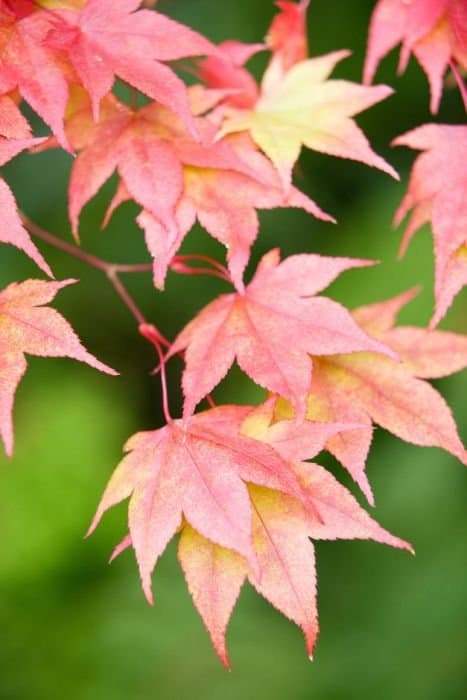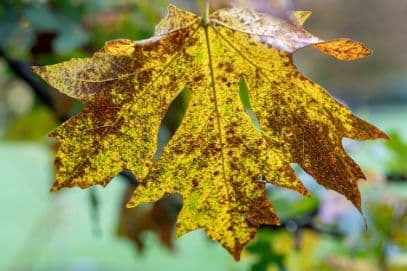Red buckeye Aesculus pavia 'Atrosanguinea'

ABOUT
The Red Buckeye, aptly named for its striking red flowers, presents a vivid display of showy blooms that are magnets for hummingbirds and butterflies. Its distinct flowers are borne in upright clusters, ranging in shade from deep red to reddish-pink, creating a warm and enchanting effect in the spring garden. These blossoms emerge from the plant's branches, providing a spectacular contrast against the backdrop of its foliage. The leaves of the Red Buckeye are palmate, meaning they resemble an open hand with fingers spreading out from the palm. Typically comprising five leaflets that radiate from a central point, the leaves are a lustrous green, giving the plant a dense and lush appearance. The leaflets themselves are elongated with a pointed tip, creating an elegant and slightly droopy look. As the flowering season ends, the Red Buckeye develops smooth, capsule-like fruits that encase the seeds. These seeds are glossy and brown, reminiscent of the "buckeyes" that give the tree its common name. The bark of the Red Buckeye is fairly smooth with a light gray to brown color, adding to the overall aesthetic appeal of the plant throughout the year. Overall, the Red Buckeye is best recognized for its remarkable springtime flowers and the bold foliage that together create a captivating display in any landscape where it graces.
About this plant
 Names
NamesFamily
Sapindaceae
Synonyms
Red Buckeye, Firecracker Plant, Scarlet Buckeye
Common names
Aesculus pavia var. flavescens, Aesculus pavia var. purpurascens, Aesculus pavia var. atrosanguinea.
 Toxicity
ToxicityTo humans
Red buckeye is toxic to humans. Ingesting any part of the plant, particularly the seeds, can lead to symptoms including nausea, diarrhea, and vomiting. In severe cases, muscle weakness and paralysis may occur. Eating large quantities of the seeds or other parts of the plant can be potentially fatal.
To pets
Red buckeye is toxic to pets. If ingested, it can cause similar symptoms to those in humans, such as vomiting, diarrhea, and abdominal pain. In serious cases, ingestion can lead to muscle weakness, coordination issues, or even paralysis. It is particularly dangerous for pets due to their smaller body size, and consuming parts of the plant can be fatal.
 Characteristics
CharacteristicsLife cycle
Perennials
Foliage type
Deciduous
Color of leaves
Green
Flower color
Red
Height
15-25 feet (4.6-7.6 meters)
Spread
15-25 feet (4.6-7.6 meters)
Plant type
Tree
Hardiness zones
4-8
Native area
Southeastern United States
Benefits
 General Benefits
General Benefits- Attractive Blooms: The red buckeye 'Atrosanguinea' produces showy red flowers that add aesthetic value to landscapes.
- Wildlife Habitat: Its flowers attract hummingbirds and other pollinators, providing a food source and promoting biodiversity.
- Shade Provider: This plant can grow into a small tree or large shrub, offering shade in garden spaces or small yards.
- Low Maintenance: Red Buckeye 'Atrosanguinea' is known for being hardy and requiring minimal upkeep once established.
- Drought Tolerance: After establishment, it shows a degree of tolerance to dry conditions, reducing the need for frequent watering.
- Adaptability: It can grow in a variety of soil types, though it prefers well-drained soils, making it versatile in different garden settings.
 Medical Properties
Medical PropertiesThis plant is not used for medical purposes.
 Air-purifying Qualities
Air-purifying QualitiesThis plant is not specifically known for air purifying qualities.
 Other Uses
Other Uses- Red buckeye seeds are sometimes carried as good luck charms or believed to bring wealth, a practice that stems from folklore.
- The finely ground seeds, despite being toxic, have historically been used as a fish stupefier by indigenous peoples.
- In woodworking, the attractive wood of red buckeye can be used to create small specialty objects, such as handles and crafts, that showcase its fine grain.
- The nectar of red buckeye flowers is used in apiculture as a honey source for bees, although the honey should not be consumed by humans due to potential toxicity.
- As a natural dye source, the bark and other parts of the plant can be utilized in traditional textile dyeing processes for varying shades of colors.
- The crushed seeds have been used as a topical pest repellent for both humans and plants, to deter various insects.
- Due to its striking spring blooms, the red buckeye can be used in cut flower arrangements as a form of ornamental horticulture.
- In landscape design, the plant is used to create a scenic focal point or as a backdrop plant because of its distinctive flowers and growth habit.
- During historical reenactments or educational demonstrations, red buckeye might be referenced or used to show traditional practices of indigenous cultures.
- Small branches and twigs from the red buckeye can be used in craft projects or as kindling for starting fires in outdoor and survival settings.
Interesting Facts
 Feng Shui
Feng ShuiThe Red Buckeye is not used in Feng Shui practice.
 Zodiac Sign Compitability
Zodiac Sign CompitabilityThe Red Buckeye is not used in astrology practice.
 Plant Symbolism
Plant Symbolism- Strength and Resilience: The Aesculus pavia, commonly known as Red Buckeye, belongs to the genus Aesculus which typically symbolizes strength and resilience due to their hardy nature and strong wood.
- Protective Qualities: Historically, some believed that carrying buckeye seeds would protect them from rheumatism and other ailments, stemming from the folklore associated with the 'lucky' buckeye charms.
- Fertility and New Beginnings: The nut-like seeds and prolific growth of the Red Buckeye represent fertility and the potential for new beginnings and growth.
 Water
WaterThe Red buckeye, commonly known as Aesculus pavia 'Atrosanguinea', prefers consistently moist soil but not waterlogged conditions. It should be watered deeply once or twice a week, depending on the weather, more frequent in dry, hot periods and less so during cooler, wetter periods. Initially after planting, ensure the plant gets about 1-2 gallons of water to help establish roots. Mature plants will require less frequent watering, but ensure they receive approximately 1.5 gallons every week during the growing season, slightly more during peak summer heat.
 Light
LightRed buckeye thrives best in full sun to partial shade. The ideal spot for this plant would be an area that receives direct sunlight for at least half of the day, but is also protected from the harsh afternoon sun, which could lead to leaf scorch.
 Temperature
TemperatureRed buckeye plants are best suited to a temperate climate and can survive a temperature range from about -20°F to 90°F. They prefer to grow in conditions where the temperature generally ranges between 60°F to 75°F. Extreme temperatures beyond the mentioned range can damage or kill the plant.
 Pruning
PruningPrune the Red buckeye to remove dead or diseased wood and to shape the plant, as its natural form is usually most desirable. Light pruning should be carried out in late winter or early spring before new growth starts. Major pruning is rarely needed, but if necessary, it should also be done during this period to avoid sap bleeding.
 Cleaning
CleaningAs needed
 Soil
SoilRed buckeye (Aesculus pavia 'Atrosanguinea') thrives best in moist, well-draining soil rich in organic matter with a slightly acidic to neutral pH level, ranging from 6.0 to 7.0. For ideal soil mix, blend loamy soil with peat moss and compost to ensure richness and good drainage.
 Repotting
RepottingRed buckeyes typically do not need frequent repotting; they can be repotted every 3-5 years or when they outgrow their current container to ensure adequate root space and soil nutrients.
 Humidity & Misting
Humidity & MistingThe best humidity conditions for Red buckeye plants are moderate to high humidity levels; they are adaptable but prefer a consistent humidity range, avoiding extremely dry conditions.
 Suitable locations
Suitable locationsIndoor
Keep Red buckeye in bright, indirect light and water moderately.
Outdoor
Plant Red buckeye in partial shade, water regularly, and mulch.
Hardiness zone
4-8 USDA
 Life cycle
Life cycleThe Red Buckeye, Aesculus pavia 'Atrosanguinea', begins its life cycle when the mature tree's flowers are pollinated, typically by bees or hummingbirds, leading to the formation of seeds enclosed in a leathery capsule. Once the seeds fall to the ground, they undergo a period of dormancy until conditions are favorable for germination, which requires a period of cold stratification. Upon sprouting, the seedling emerges and, if in a suitable environment, develops a taproot, followed by the growth of foliage. The plant then enters a juvenile phase, where it grows rapidly and produces simple, oppositely arranged leaves. After several years, the Red Buckeye reaches maturity, develops characteristic palmately compound leaves, and starts the reproductive cycle by producing its own vivid red flowers during spring. The mature Red Buckeye can then produce seeds annually, continuing the cycle as long as the tree remains healthy and the necessary conditions for growth and reproduction are met.
 Propogation
PropogationPropogation time
Spring-Early Summer
The Red Buckeye, Aesculus pavia 'Atrosanguinea', is commonly propagated by seed. The best time to sow seeds is in the autumn, directly after they mature, which ensures they don't dry out and have a cold period to break dormancy. To propagate by seed, collect the seeds as soon as they fall from the tree and remove the outer husk. Sow them immediately at a depth of about 1 to 2 inches (2.5 to 5 centimeters) in well-drained soil and in a sunny location. Seedlings can be expected to emerge the following spring. The fresh seeds have a high germination rate, but this decreases rapidly as the seeds dry out, so timely sowing is key to successful propagation.








